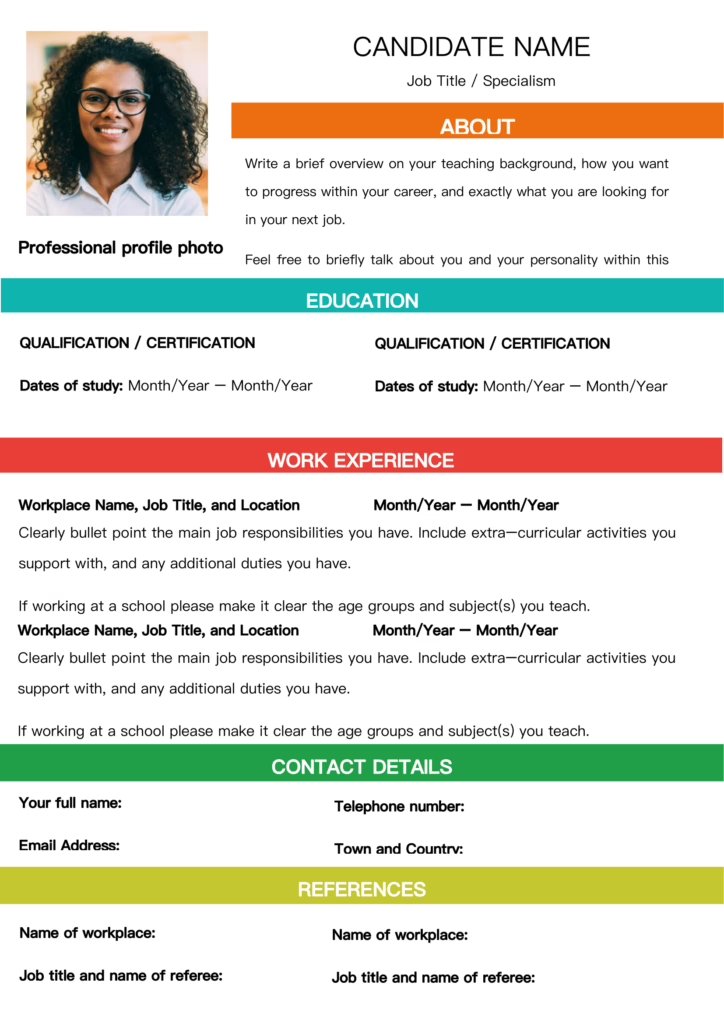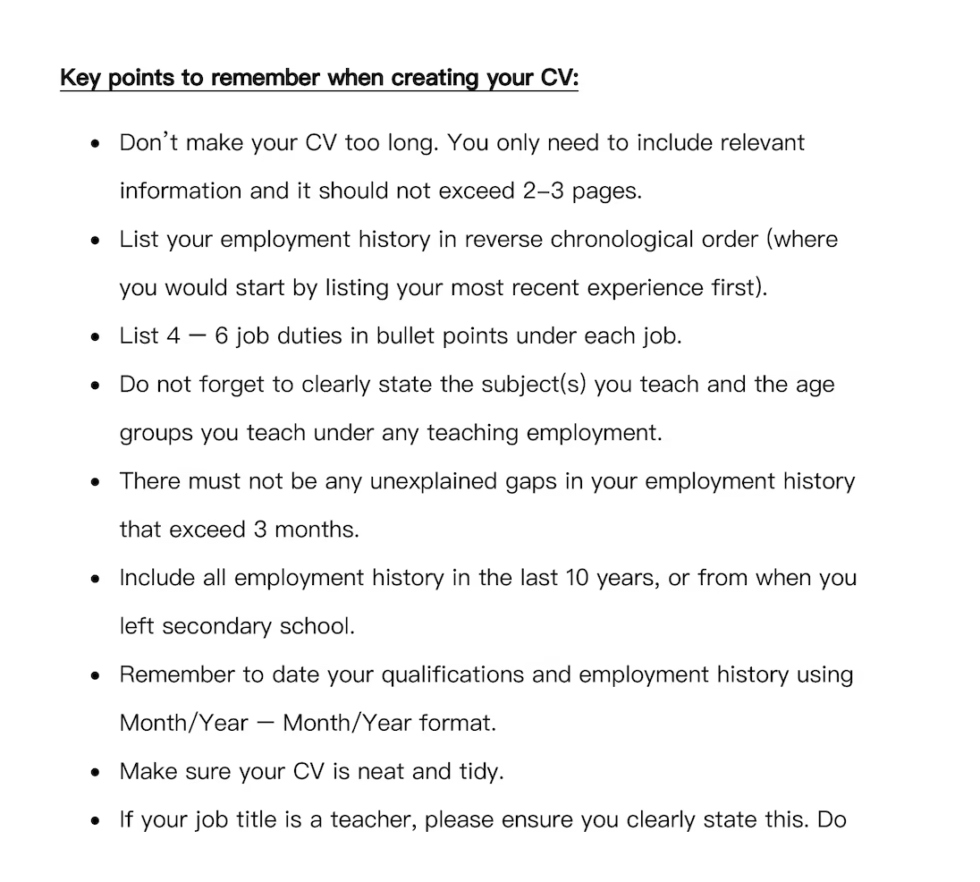In this in-depth guide, we will delve into the essential elements of crafting a standout teaching CV in the UK. From expert tips on formatting and structuring to strategies for highlighting your skills and experience, this comprehensive resource is designed to help educators create a compelling CV that stands out in the competitive job market. Whether you’re a seasoned teacher or a qualified professional, this article offers valuable insights and practical advice to elevate your CV and showcase your qualifications.
Introduction to UK CV Format for Teachers
A well-crafted teacher CV is an essential tool for educators in the UK to showcase their qualifications, skills, and experience to potential employers. In a competitive job market, a standout CV can make a significant difference in securing teaching positions, whether in primary, secondary, special education, or leadership roles. This comprehensive guide aims to provide educators with expert tips and strategies for creating a compelling teaching CV that highlights their professional profile.
Understanding the Basics of Teacher CV
A teacher CV, also known as a curriculum vitae, is a detailed document that outlines an individual’s educational and professional background, including teaching experience, qualifications, skills, and accomplishments. It is important to note that in the UK, a CV is used for academic and education-related positions, while a resume is more used in other industries. When crafting a CV, it’s crucial to adhere to the UK format and guidelines, ensuring that the document is tailored for the education sector.
In the UK, a CV is generally longer than a resume, often spanning two or more pages to accommodate comprehensive details about an educator’s career. The formatting guidelines for a CV in the UK emphasise clarity, professionalism, and readability, with a focus on presenting information in a structured and organised manner.
Structuring Your CV for Greatest Impact
When structuring a teacher CV, it’s important to include the following key sections:
- Contact information and personal details
- Professional summary or personal statement
- Education and qualifications
- Teaching experience
- Additional skills and certifications
- Hobbies and interests (optional)
Each section should be labelled and organised to ensure easy navigation for the reader. The content within each section should be presented in a concise and impactful manner, highlighting the educator’s strengths and achievements.
Expert Tips for Formatting Your CV
Formatting plays a crucial role in the presentation of a CV. Here are some expert tips for effective formatting:
- Choosing the right font and font size to ensure readability
- Using bullet points for easy scanning of key information
- Incorporating bold and italic text to emphasise important details
- Ensuring consistent formatting throughout the CV for a professional look
Showcasing Your Skills and Experience
In the competitive landscape of education, it’s essential to showcase key teaching skills, competencies, and experience in a CV. This involves:
- Highlighting specific teaching skills and competencies relevant to the role
- Demonstrating impact and achievements in previous teaching roles
- Incorporating relevant teaching methodologies and approaches used
- Emphasising professional development and continuous learning through certifications and training
Tailoring Your CV for Different Roles
Customising a CV for specific roles is crucial in aligning with the requirements of different teaching positions. This includes:
- Adapting the CV for primary school, secondary school, or special education roles
- Showcasing leadership and administrative experience for relevant positions
- Highlighting specific subject area expertise or experience with particular age groups
Primary School CV Tips
- Primary Education Focus: Highlight experience with children aged 4-11 and understanding of UK primary curriculum.
- Differentiation & Inclusion: Show ability to tailor teaching for diverse needs, including SEN and EAL.
- Engagement & Creativity: Showcase interactive lessons and innovative teaching methods.
- Behaviour Management: Discuss strategies for fostering positive behaviour and inclusive classroom culture.
- Parental Communication: Highlight skills in building positive relationships and involving parents in education.
- Cross-Curricular Integration: Illustrate how you integrate subjects to create cohesive learning experiences.
- Technology Integration: Mention proficiency in using educational technology to enhance teaching.
- Passion for Primary Education: Convey enthusiasm for working with young children and commitment to their development.
- Professional Development: Show dedication to ongoing learning and involvement in educational communities.
- Clear Format & Proofreading: Ensure CV is well-organised, error-free, and tailored to the job application.
Secondary School CV Tips
- Subject Specialisation: Highlight expertise in a specific subject area for secondary education (e.g., Maths, English, Science).
- Key Stage Focus: Emphasise experience and understanding of Key Stages 3, 4, or 5, depending on the target age group.
- Differentiation & Inclusion: Showcase ability to differentiate instruction for diverse learners, including SEN and EAL students.
- Engagement & Differentiation: Demonstrate use of engaging teaching methods and differentiation techniques tailored to secondary students.
- Behaviour Management: Discuss strategies for maintaining positive behaviour and a conducive learning environment in secondary classrooms.
- Assessment & Feedback: Highlight skills in designing assessments and providing constructive feedback to support student progress.
- Curriculum Alignment: Illustrate alignment with national curriculum standards and ability to develop lesson plans accordingly.
- Technology Integration: Mention proficiency in integrating technology tools and resources to enhance teaching and learning in secondary education.
- Collaboration & Professionalism: Showcase ability to collaborate with colleagues, engage with parents, and contribute to the wider school community.
- Continuous Professional Development: Show commitment to ongoing professional development and staying updated with educational trends and best practices.
Incorporating Keywords and Phrases for ATS
Applicant Tracking Systems (ATS) are used by employers to manage and filter job applications. To ensure that a teaching CV is ATS-friendly, it’s important to:
- Identify and incorporate relevant keywords and phrases specific to teaching roles
- Balance keyword optimisation with natural language and readability for human reviewers
The Dos and Don’ts of Writing a Teaching CV
When crafting, it’s important to adhere to best practices and avoid common pitfalls. Some dos and don’ts include:
Dos:
- Including quantifiable achievements and outcomes
- Using action verbs to describe responsibilities and accomplishments
- Proofreading the CV for errors and inconsistencies
Don’ts:
- Including irrelevant personal information such as marital status or age
- Using clichés or generic language that does not add value
- Including negative language or disparaging remarks about previous experiences
Making Your CV Stand Out
To make a teaching CV stand out, educators can consider:
- Using a professional and appealing template
- Incorporating visual elements such as icons or infographics (if appropriate)
- Showcasing unique teaching initiatives or projects that show innovation and impact
Extra Considerations for a CV in the UK
Besides to the core sections of a teaching CV, educators should also consider:
- Including information about Disclosure and Barring Service (DBS) checks, which are often required for teaching positions
- Providing references and testimonials from previous employers or colleagues
- Adhering to best practices for writing a cover letter when submitting a teaching CV
Finalising and Reviewing
Before finalising a CV, educators should:
- Proofread the document for spelling and grammar errors
- Seek feedback from colleagues or mentors to ensure the CV represents their professional profile
- Save and submit the CV in the appropriate format specified by the employer or application guidelines
Teacher CV Example and Downloadable Template


Conclusion
Crafting a standout teaching CV in the UK requires careful attention to detail, strategic presentation of skills and experience, and adherence to industry-specific guidelines. By applying the expert tips and strategies outlined in this guide, educators can elevate their teaching CVs and increase their chances of securing rewarding teaching positions. Whether a seasoned teacher or a qualified professional, the insights and practical advice offered in this article are designed to empower educators in creating impactful teacher CVs that resonate with prospective employers.




